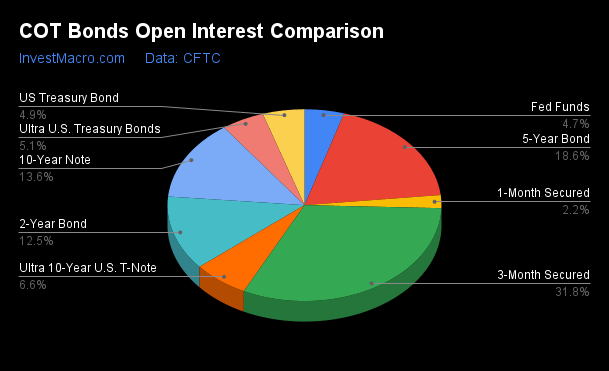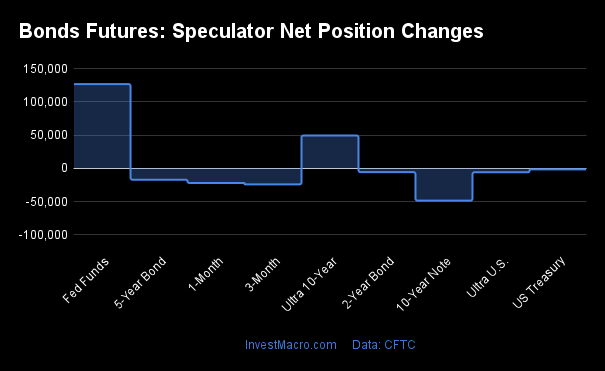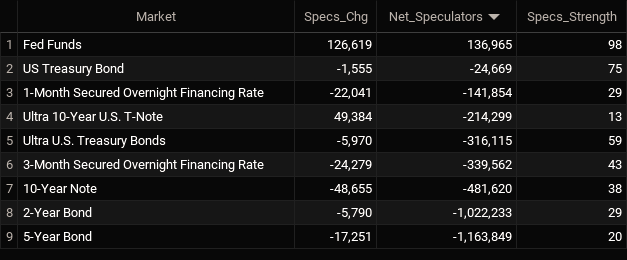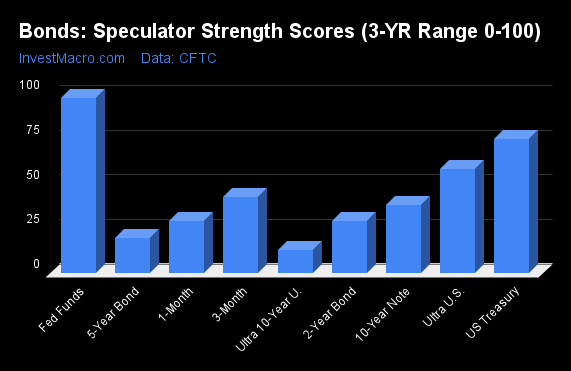By InvestMacro
Here are the latest charts and statistics for the Commitment of Traders (COT) reports data published by the Commodities Futures Trading Commission (CFTC).
The latest COT data is updated through Tuesday May 7th and shows a quick view of how large traders (for-profit speculators and commercial hedgers) were positioned in the futures markets.
Weekly Speculator Changes led by Fed Funds & Ultra 10-Year Bonds
The COT bond market speculator bets were lower this week as just two out of the eight bond markets we cover had higher positioning while the other six markets had lower speculator contracts.
Free Reports:
 Get our Weekly Commitment of Traders Reports - See where the biggest traders (Hedge Funds and Commercial Hedgers) are positioned in the futures markets on a weekly basis.
Get our Weekly Commitment of Traders Reports - See where the biggest traders (Hedge Funds and Commercial Hedgers) are positioned in the futures markets on a weekly basis.
 Sign Up for Our Stock Market Newsletter – Get updated on News, Charts & Rankings of Public Companies when you join our Stocks Newsletter
Sign Up for Our Stock Market Newsletter – Get updated on News, Charts & Rankings of Public Companies when you join our Stocks Newsletter
Leading the gains for the bond markets was the Fed Funds (126,619 contracts) with the Ultra 10-Year Bonds (49,384 contracts) also having a positive week.
The bond markets with declines in speculator bets for the week were the 10-Year Bonds (-48,655 contracts), the 5-Year Bonds (-17,251 contracts), the SOFR 3-Months (-24,279 contracts), the Ultra Treasury Bonds (-5,970 contracts), the 2-Year Bonds (-5,790 contracts) and the US Treasury Bonds (-1,555 contracts) also recording lower bets on the week.
Bonds Net Speculators Leaderboard
Legend: Weekly Speculators Change | Speculators Current Net Position | Speculators Strength Score compared to last 3-Years (0-100 range)
Strength Scores led by Fed Funds & US Treasury Bonds
COT Strength Scores (a normalized measure of Speculator positions over a 3-Year range, from 0 to 100 where above 80 is Extreme-Bullish and below 20 is Extreme-Bearish) showed that the Fed Funds (98 percent) and the US Treasury Bonds (75 percent) lead the bond markets this week. The Ultra Treasury Bonds (58 percent) come in as the next highest in the weekly strength scores.
On the downside, the Ultra 10-Year Bonds (13 percent) and the 5-Year Bonds (19 percent) come in at the lowest strength level currently and are in Extreme-Bearish territory (below 20 percent). The next lowest strength scores were the 2-Year Bonds (29 percent) and the 10-Year Bonds (38 percent).
Strength Statistics:
Fed Funds (97.8 percent) vs Fed Funds previous week (70.8 percent)
2-Year Bond (29.0 percent) vs 2-Year Bond previous week (29.4 percent)
5-Year Bond (19.5 percent) vs 5-Year Bond previous week (20.6 percent)
10-Year Bond (38.1 percent) vs 10-Year Bond previous week (42.6 percent)
Ultra 10-Year Bond (12.9 percent) vs Ultra 10-Year Bond previous week (2.9 percent)
US Treasury Bond (74.9 percent) vs US Treasury Bond previous week (75.4 percent)
Ultra US Treasury Bond (58.5 percent) vs Ultra US Treasury Bond previous week (60.9 percent)
SOFR 3-Months (42.7 percent) vs SOFR 3-Months previous week (44.0 percent)
Fed Funds top the 6-Week Strength Trends
COT Strength Score Trends (or move index, calculates the 6-week changes in strength scores) showed that the Fed Funds (68 percent) leads the past six weeks trends for bonds. The 10-Year Bonds (9 percent) are the next highest positive mover in the latest trends data.
The SOFR 3-Months (-35 percent) and the Ultra 10-Year Bonds (-16 percent) lead the downside trend scores currently with the Ultra Treasury Bonds (-7 percent) and the 2-Year Bonds (-7 percent) following next with lower trend scores.
Strength Trend Statistics:
Fed Funds (67.7 percent) vs Fed Funds previous week (43.8 percent)
2-Year Bond (-6.9 percent) vs 2-Year Bond previous week (-7.3 percent)
5-Year Bond (-0.9 percent) vs 5-Year Bond previous week (0.7 percent)
10-Year Bond (9.0 percent) vs 10-Year Bond previous week (13.2 percent)
Ultra 10-Year Bond (-15.5 percent) vs Ultra 10-Year Bond previous week (-22.4 percent)
US Treasury Bond (-1.4 percent) vs US Treasury Bond previous week (-0.2 percent)
Ultra US Treasury Bond (-7.3 percent) vs Ultra US Treasury Bond previous week (-2.3 percent)
SOFR 3-Months (-34.5 percent) vs SOFR 3-Months previous week (-31.9 percent)
Secured Overnight Financing Rate (3-Month) Futures:
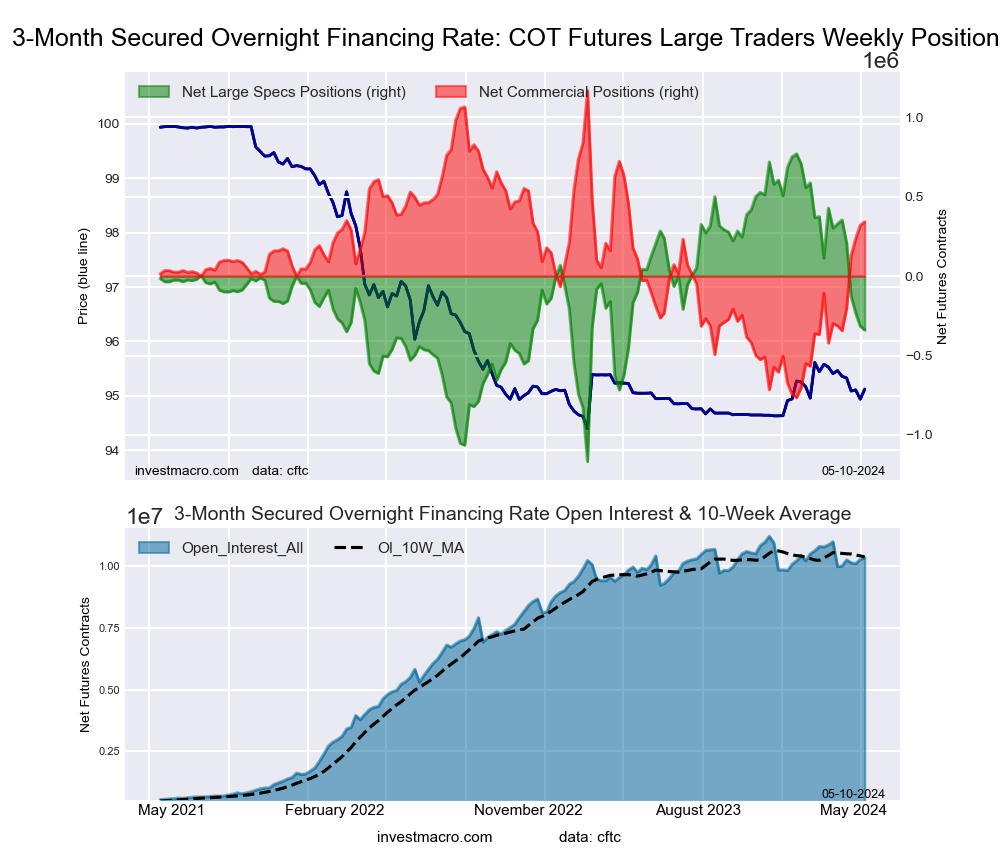 The Secured Overnight Financing Rate (3-Month) large speculator standing this week came in at a net position of -339,562 contracts in the data reported through Tuesday. This was a weekly decrease of -24,279 contracts from the previous week which had a total of -315,283 net contracts.
The Secured Overnight Financing Rate (3-Month) large speculator standing this week came in at a net position of -339,562 contracts in the data reported through Tuesday. This was a weekly decrease of -24,279 contracts from the previous week which had a total of -315,283 net contracts.
This week’s current strength score (the trader positioning range over the past three years, measured from 0 to 100) shows the speculators are currently Bearish with a score of 42.7 percent. The commercials are Bullish with a score of 57.3 percent and the small traders (not shown in chart) are Bullish-Extreme with a score of 86.7 percent.
Price Trend-Following Model: Weak Uptrend
Our weekly trend-following model classifies the current market price position as: Weak Uptrend. The current action for the model is considered to be: Hold – Maintain Long Position.
| SOFR 3-Months Statistics | SPECULATORS | COMMERCIALS | SMALL TRADERS |
| – Percent of Open Interest Longs: | 14.0 | 59.4 | 0.4 |
| – Percent of Open Interest Shorts: | 17.3 | 56.1 | 0.4 |
| – Net Position: | -339,562 | 341,716 | -2,154 |
| – Gross Longs: | 1,446,213 | 6,144,809 | 36,213 |
| – Gross Shorts: | 1,785,775 | 5,803,093 | 38,367 |
| – Long to Short Ratio: | 0.8 to 1 | 1.1 to 1 | 0.9 to 1 |
| NET POSITION TREND: | |||
| – Strength Index Score (3 Year Range Pct): | 42.7 | 57.3 | 86.7 |
| – Strength Index Reading (3 Year Range): | Bearish | Bullish | Bullish-Extreme |
| NET POSITION MOVEMENT INDEX: | |||
| – 6-Week Change in Strength Index: | -34.5 | 33.9 | 7.5 |
30-Day Federal Funds Futures:
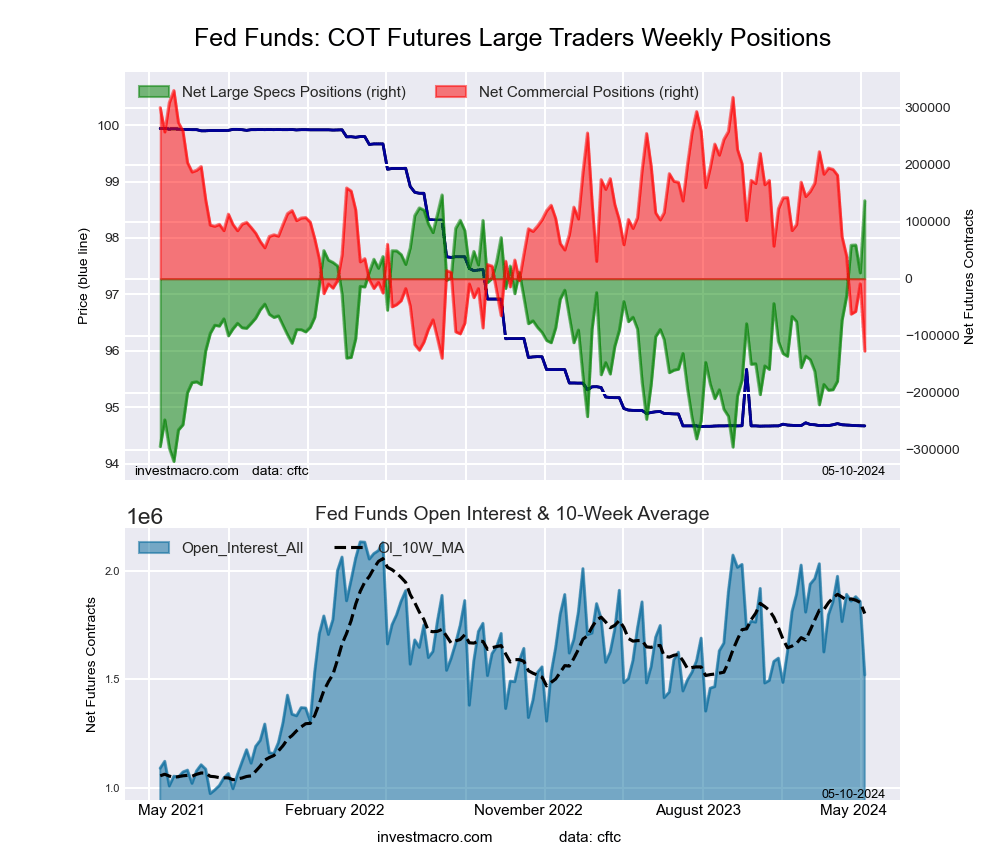 The 30-Day Federal Funds large speculator standing this week came in at a net position of 136,965 contracts in the data reported through Tuesday. This was a weekly lift of 126,619 contracts from the previous week which had a total of 10,346 net contracts.
The 30-Day Federal Funds large speculator standing this week came in at a net position of 136,965 contracts in the data reported through Tuesday. This was a weekly lift of 126,619 contracts from the previous week which had a total of 10,346 net contracts.
This week’s current strength score (the trader positioning range over the past three years, measured from 0 to 100) shows the speculators are currently Bullish-Extreme with a score of 97.8 percent. The commercials are Bearish-Extreme with a score of 2.7 percent and the small traders (not shown in chart) are Bullish with a score of 71.5 percent.
Price Trend-Following Model: Downtrend
Our weekly trend-following model classifies the current market price position as: Downtrend. The current action for the model is considered to be: Hold – Maintain Short Position.
| 30-Day Federal Funds Statistics | SPECULATORS | COMMERCIALS | SMALL TRADERS |
| – Percent of Open Interest Longs: | 23.5 | 54.8 | 2.0 |
| – Percent of Open Interest Shorts: | 14.4 | 63.2 | 2.6 |
| – Net Position: | 136,965 | -127,034 | -9,931 |
| – Gross Longs: | 356,452 | 833,174 | 30,131 |
| – Gross Shorts: | 219,487 | 960,208 | 40,062 |
| – Long to Short Ratio: | 1.6 to 1 | 0.9 to 1 | 0.8 to 1 |
| NET POSITION TREND: | |||
| – Strength Index Score (3 Year Range Pct): | 97.8 | 2.7 | 71.5 |
| – Strength Index Reading (3 Year Range): | Bullish-Extreme | Bearish-Extreme | Bullish |
| NET POSITION MOVEMENT INDEX: | |||
| – 6-Week Change in Strength Index: | 67.7 | -65.7 | -15.7 |
2-Year Treasury Note Futures:
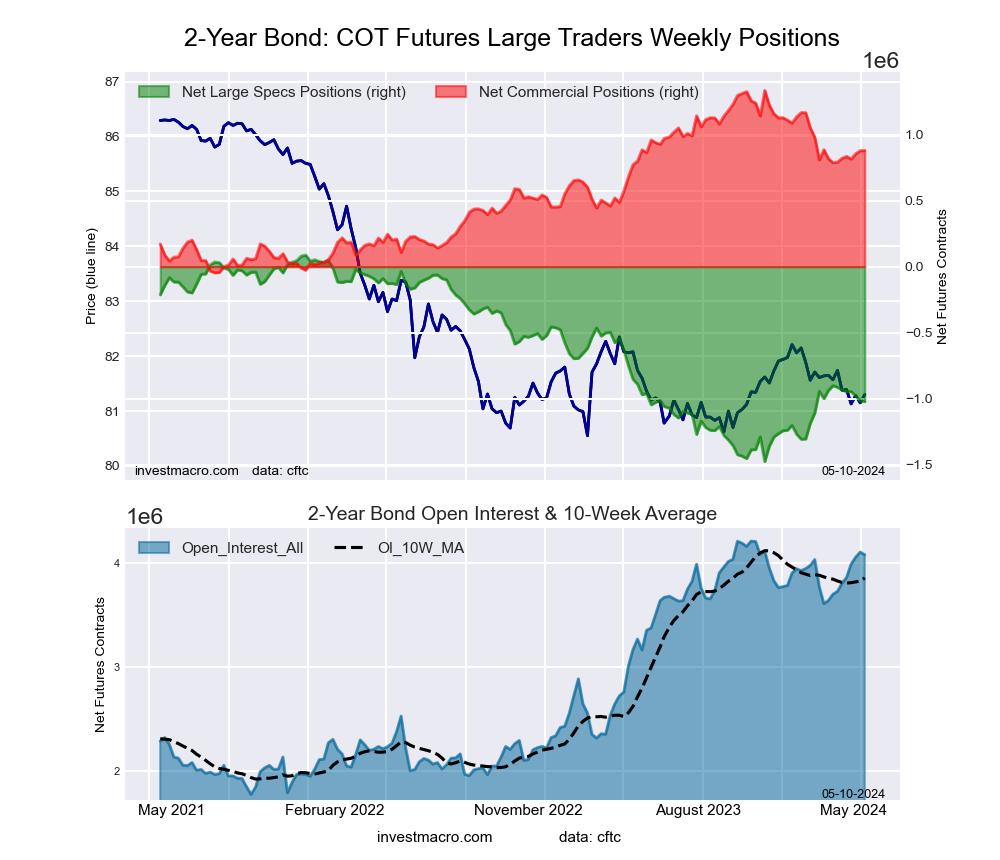 The 2-Year Treasury Note large speculator standing this week came in at a net position of -1,022,233 contracts in the data reported through Tuesday. This was a weekly fall of -5,790 contracts from the previous week which had a total of -1,016,443 net contracts.
The 2-Year Treasury Note large speculator standing this week came in at a net position of -1,022,233 contracts in the data reported through Tuesday. This was a weekly fall of -5,790 contracts from the previous week which had a total of -1,016,443 net contracts.
This week’s current strength score (the trader positioning range over the past three years, measured from 0 to 100) shows the speculators are currently Bearish with a score of 29.0 percent. The commercials are Bullish with a score of 67.1 percent and the small traders (not shown in chart) are Bullish-Extreme with a score of 97.9 percent.
Price Trend-Following Model: Downtrend
Our weekly trend-following model classifies the current market price position as: Downtrend. The current action for the model is considered to be: Hold – Maintain Short Position.
| 2-Year Treasury Note Statistics | SPECULATORS | COMMERCIALS | SMALL TRADERS |
| – Percent of Open Interest Longs: | 12.7 | 79.2 | 6.6 |
| – Percent of Open Interest Shorts: | 37.7 | 57.6 | 3.1 |
| – Net Position: | -1,022,233 | 880,495 | 141,738 |
| – Gross Longs: | 516,333 | 3,230,397 | 269,053 |
| – Gross Shorts: | 1,538,566 | 2,349,902 | 127,315 |
| – Long to Short Ratio: | 0.3 to 1 | 1.4 to 1 | 2.1 to 1 |
| NET POSITION TREND: | |||
| – Strength Index Score (3 Year Range Pct): | 29.0 | 67.1 | 97.9 |
| – Strength Index Reading (3 Year Range): | Bearish | Bullish | Bullish-Extreme |
| NET POSITION MOVEMENT INDEX: | |||
| – 6-Week Change in Strength Index: | -6.9 | 6.4 | 7.7 |
5-Year Treasury Note Futures:
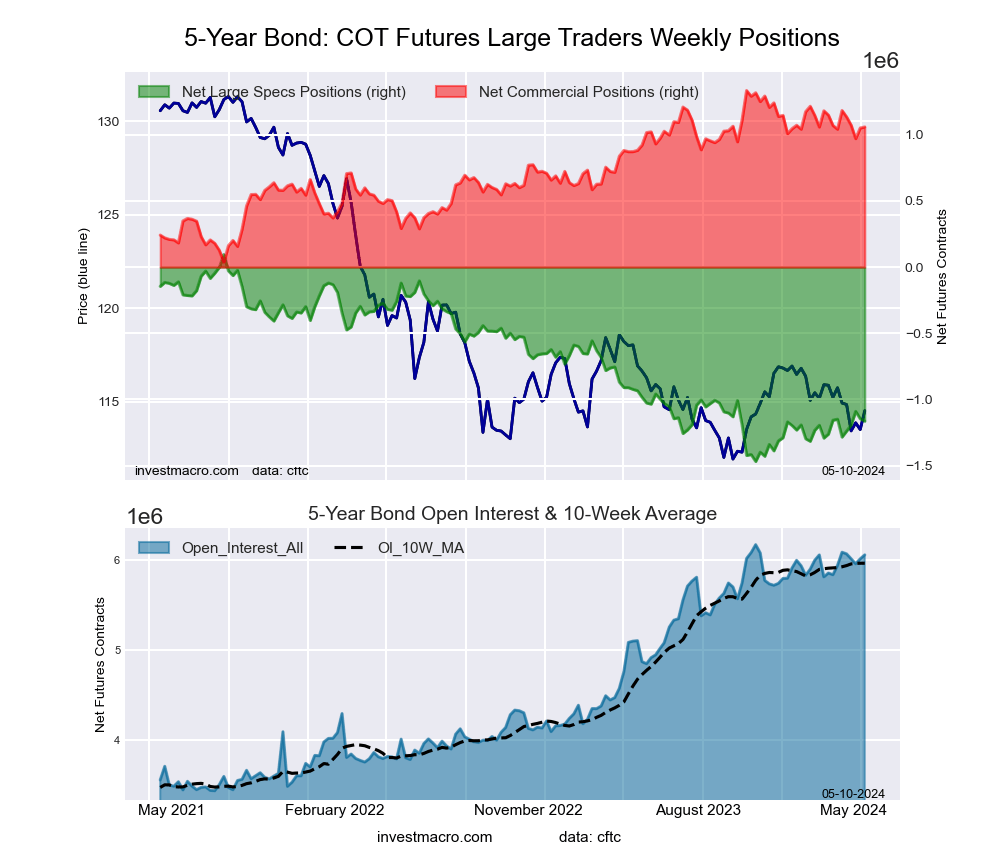 The 5-Year Treasury Note large speculator standing this week came in at a net position of -1,163,849 contracts in the data reported through Tuesday. This was a weekly decline of -17,251 contracts from the previous week which had a total of -1,146,598 net contracts.
The 5-Year Treasury Note large speculator standing this week came in at a net position of -1,163,849 contracts in the data reported through Tuesday. This was a weekly decline of -17,251 contracts from the previous week which had a total of -1,146,598 net contracts.
This week’s current strength score (the trader positioning range over the past three years, measured from 0 to 100) shows the speculators are currently Bearish-Extreme with a score of 19.5 percent. The commercials are Bullish with a score of 78.8 percent and the small traders (not shown in chart) are Bullish-Extreme with a score of 85.0 percent.
Price Trend-Following Model: Downtrend
Our weekly trend-following model classifies the current market price position as: Downtrend. The current action for the model is considered to be: Hold – Maintain Short Position.
| 5-Year Treasury Note Statistics | SPECULATORS | COMMERCIALS | SMALL TRADERS |
| – Percent of Open Interest Longs: | 8.0 | 83.2 | 7.1 |
| – Percent of Open Interest Shorts: | 27.2 | 65.7 | 5.4 |
| – Net Position: | -1,163,849 | 1,059,427 | 104,422 |
| – Gross Longs: | 483,030 | 5,038,983 | 429,855 |
| – Gross Shorts: | 1,646,879 | 3,979,556 | 325,433 |
| – Long to Short Ratio: | 0.3 to 1 | 1.3 to 1 | 1.3 to 1 |
| NET POSITION TREND: | |||
| – Strength Index Score (3 Year Range Pct): | 19.5 | 78.8 | 85.0 |
| – Strength Index Reading (3 Year Range): | Bearish-Extreme | Bullish | Bullish-Extreme |
| NET POSITION MOVEMENT INDEX: | |||
| – 6-Week Change in Strength Index: | -0.9 | 1.3 | -0.7 |
10-Year Treasury Note Futures:
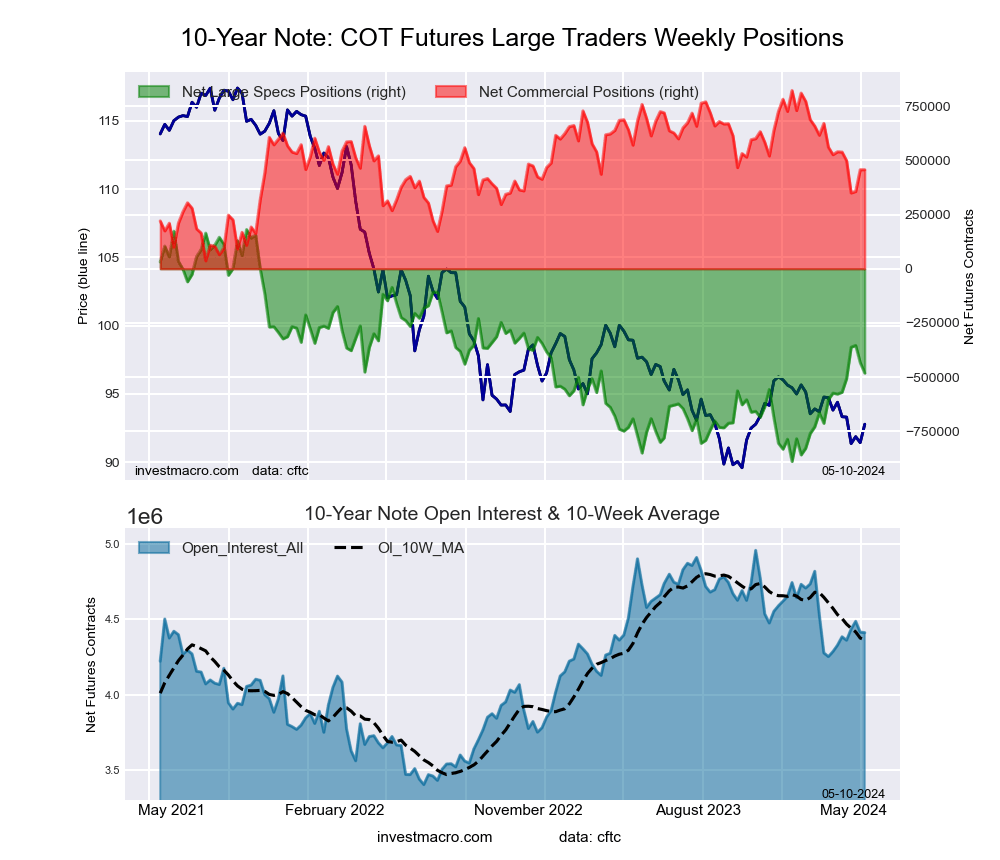 The 10-Year Treasury Note large speculator standing this week came in at a net position of -481,620 contracts in the data reported through Tuesday. This was a weekly decline of -48,655 contracts from the previous week which had a total of -432,965 net contracts.
The 10-Year Treasury Note large speculator standing this week came in at a net position of -481,620 contracts in the data reported through Tuesday. This was a weekly decline of -48,655 contracts from the previous week which had a total of -432,965 net contracts.
This week’s current strength score (the trader positioning range over the past three years, measured from 0 to 100) shows the speculators are currently Bearish with a score of 38.1 percent. The commercials are Bullish with a score of 53.5 percent and the small traders (not shown in chart) are Bullish with a score of 78.8 percent.
Price Trend-Following Model: Downtrend
Our weekly trend-following model classifies the current market price position as: Downtrend. The current action for the model is considered to be: Hold – Maintain Short Position.
| 10-Year Treasury Note Statistics | SPECULATORS | COMMERCIALS | SMALL TRADERS |
| – Percent of Open Interest Longs: | 10.3 | 77.9 | 9.3 |
| – Percent of Open Interest Shorts: | 21.2 | 67.6 | 8.8 |
| – Net Position: | -481,620 | 457,222 | 24,398 |
| – Gross Longs: | 455,924 | 3,437,718 | 411,798 |
| – Gross Shorts: | 937,544 | 2,980,496 | 387,400 |
| – Long to Short Ratio: | 0.5 to 1 | 1.2 to 1 | 1.1 to 1 |
| NET POSITION TREND: | |||
| – Strength Index Score (3 Year Range Pct): | 38.1 | 53.5 | 78.8 |
| – Strength Index Reading (3 Year Range): | Bearish | Bullish | Bullish |
| NET POSITION MOVEMENT INDEX: | |||
| – 6-Week Change in Strength Index: | 9.0 | -10.6 | -3.0 |
Ultra 10-Year Notes Futures:
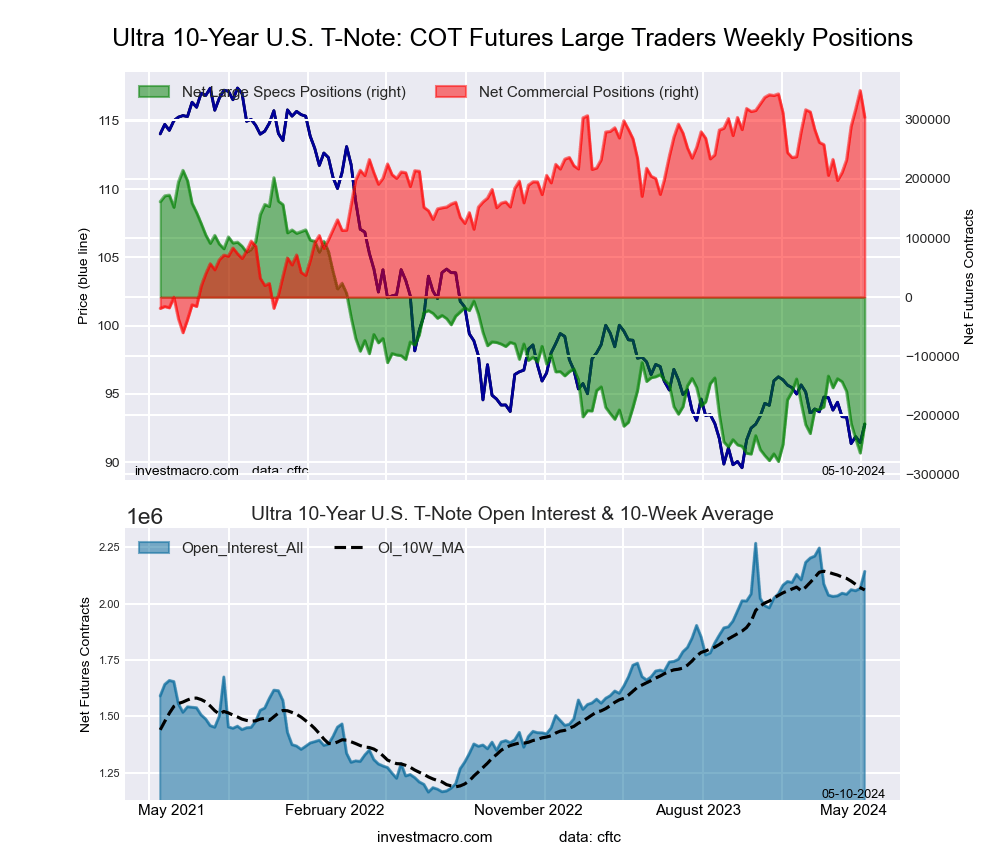 The Ultra 10-Year Notes large speculator standing this week came in at a net position of -214,299 contracts in the data reported through Tuesday. This was a weekly gain of 49,384 contracts from the previous week which had a total of -263,683 net contracts.
The Ultra 10-Year Notes large speculator standing this week came in at a net position of -214,299 contracts in the data reported through Tuesday. This was a weekly gain of 49,384 contracts from the previous week which had a total of -263,683 net contracts.
This week’s current strength score (the trader positioning range over the past three years, measured from 0 to 100) shows the speculators are currently Bearish-Extreme with a score of 12.9 percent. The commercials are Bullish-Extreme with a score of 89.0 percent and the small traders (not shown in chart) are Bullish with a score of 60.5 percent.
Price Trend-Following Model: Weak Uptrend
Our weekly trend-following model classifies the current market price position as: Weak Uptrend. The current action for the model is considered to be: Hold – Maintain Long Position.
| Ultra 10-Year Notes Statistics | SPECULATORS | COMMERCIALS | SMALL TRADERS |
| – Percent of Open Interest Longs: | 12.5 | 76.3 | 9.6 |
| – Percent of Open Interest Shorts: | 22.5 | 62.1 | 13.8 |
| – Net Position: | -214,299 | 304,341 | -90,042 |
| – Gross Longs: | 268,050 | 1,635,316 | 205,566 |
| – Gross Shorts: | 482,349 | 1,330,975 | 295,608 |
| – Long to Short Ratio: | 0.6 to 1 | 1.2 to 1 | 0.7 to 1 |
| NET POSITION TREND: | |||
| – Strength Index Score (3 Year Range Pct): | 12.9 | 89.0 | 60.5 |
| – Strength Index Reading (3 Year Range): | Bearish-Extreme | Bullish-Extreme | Bullish |
| NET POSITION MOVEMENT INDEX: | |||
| – 6-Week Change in Strength Index: | -15.5 | 26.1 | -18.2 |
US Treasury Bonds Futures:
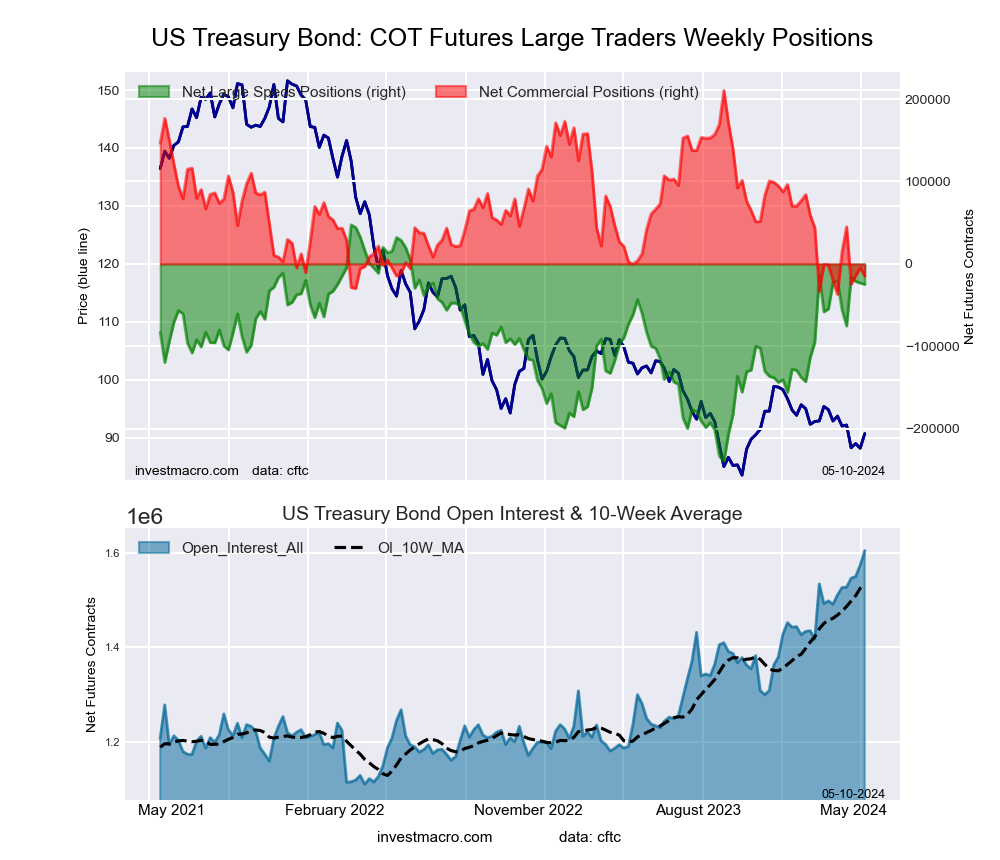 The US Treasury Bonds large speculator standing this week came in at a net position of -24,669 contracts in the data reported through Tuesday. This was a weekly lowering of -1,555 contracts from the previous week which had a total of -23,114 net contracts.
The US Treasury Bonds large speculator standing this week came in at a net position of -24,669 contracts in the data reported through Tuesday. This was a weekly lowering of -1,555 contracts from the previous week which had a total of -23,114 net contracts.
This week’s current strength score (the trader positioning range over the past three years, measured from 0 to 100) shows the speculators are currently Bullish with a score of 74.9 percent. The commercials are Bearish-Extreme with a score of 8.8 percent and the small traders (not shown in chart) are Bullish with a score of 76.7 percent.
Price Trend-Following Model: Downtrend
Our weekly trend-following model classifies the current market price position as: Downtrend. The current action for the model is considered to be: Hold – Maintain Short Position.
| US Treasury Bonds Statistics | SPECULATORS | COMMERCIALS | SMALL TRADERS |
| – Percent of Open Interest Longs: | 16.7 | 69.6 | 12.6 |
| – Percent of Open Interest Shorts: | 18.2 | 70.5 | 10.2 |
| – Net Position: | -24,669 | -14,890 | 39,559 |
| – Gross Longs: | 267,918 | 1,116,846 | 202,830 |
| – Gross Shorts: | 292,587 | 1,131,736 | 163,271 |
| – Long to Short Ratio: | 0.9 to 1 | 1.0 to 1 | 1.2 to 1 |
| NET POSITION TREND: | |||
| – Strength Index Score (3 Year Range Pct): | 74.9 | 8.8 | 76.7 |
| – Strength Index Reading (3 Year Range): | Bullish | Bearish-Extreme | Bullish |
| NET POSITION MOVEMENT INDEX: | |||
| – 6-Week Change in Strength Index: | -1.4 | 8.8 | -13.2 |
Ultra US Treasury Bonds Futures:
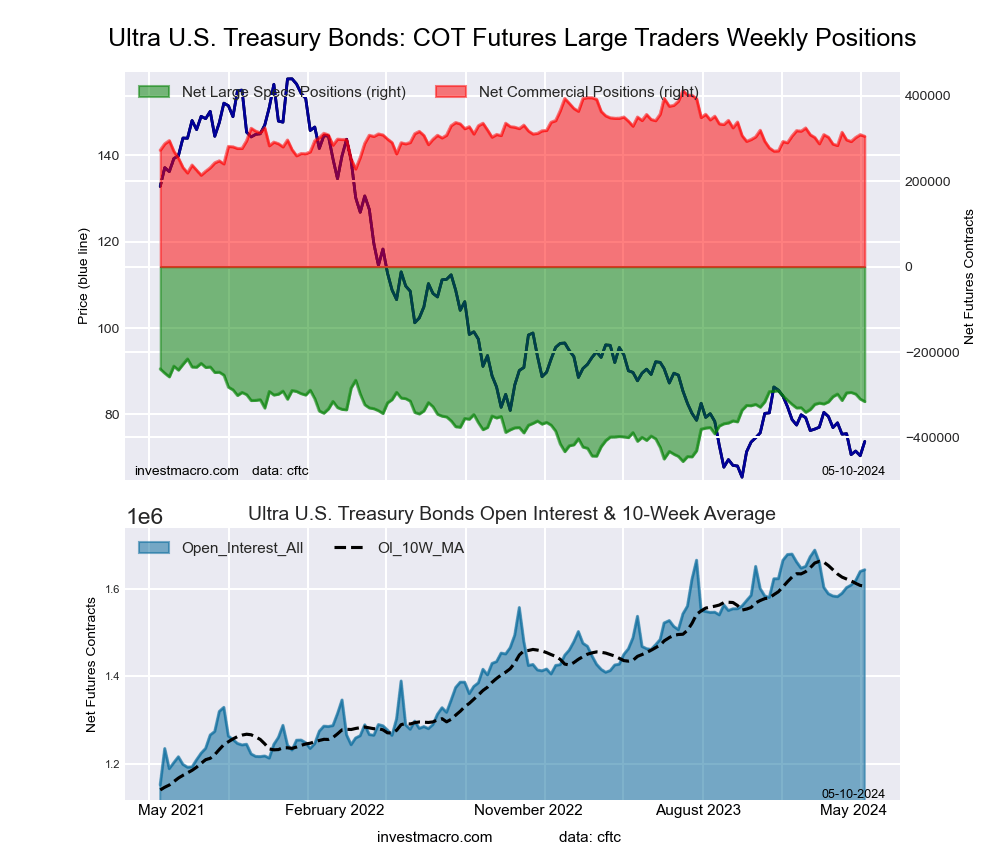 The Ultra US Treasury Bonds large speculator standing this week came in at a net position of -316,115 contracts in the data reported through Tuesday. This was a weekly fall of -5,970 contracts from the previous week which had a total of -310,145 net contracts.
The Ultra US Treasury Bonds large speculator standing this week came in at a net position of -316,115 contracts in the data reported through Tuesday. This was a weekly fall of -5,970 contracts from the previous week which had a total of -310,145 net contracts.
This week’s current strength score (the trader positioning range over the past three years, measured from 0 to 100) shows the speculators are currently Bullish with a score of 58.5 percent. The commercials are Bearish with a score of 45.9 percent and the small traders (not shown in chart) are Bearish with a score of 46.8 percent.
Price Trend-Following Model: Downtrend
Our weekly trend-following model classifies the current market price position as: Downtrend. The current action for the model is considered to be: Hold – Maintain Short Position.
| Ultra US Treasury Bonds Statistics | SPECULATORS | COMMERCIALS | SMALL TRADERS |
| – Percent of Open Interest Longs: | 9.0 | 79.8 | 10.8 |
| – Percent of Open Interest Shorts: | 28.2 | 61.3 | 10.1 |
| – Net Position: | -316,115 | 305,248 | 10,867 |
| – Gross Longs: | 147,986 | 1,312,271 | 176,682 |
| – Gross Shorts: | 464,101 | 1,007,023 | 165,815 |
| – Long to Short Ratio: | 0.3 to 1 | 1.3 to 1 | 1.1 to 1 |
| NET POSITION TREND: | |||
| – Strength Index Score (3 Year Range Pct): | 58.5 | 45.9 | 46.8 |
| – Strength Index Reading (3 Year Range): | Bullish | Bearish | Bearish |
| NET POSITION MOVEMENT INDEX: | |||
| – 6-Week Change in Strength Index: | -7.3 | 10.8 | -3.8 |
Article By InvestMacro – Receive our weekly COT Newsletter
*COT Report: The COT data, released weekly to the public each Friday, is updated through the most recent Tuesday (data is 3 days old) and shows a quick view of how large speculators or non-commercials (for-profit traders) were positioned in the futures markets.
The CFTC categorizes trader positions according to commercial hedgers (traders who use futures contracts for hedging as part of the business), non-commercials (large traders who speculate to realize trading profits) and nonreportable traders (usually small traders/speculators) as well as their open interest (contracts open in the market at time of reporting). See CFTC criteria here.

- EUR/USD Hits Three-Year High as US White House Policy Concerns Mount Apr 21, 2025
- Today is Good Friday — most financial markets will be closed Apr 18, 2025
- EUR/USD in Equilibrium: Quiet Trading Expected on Good Friday Apr 18, 2025
- The Bank of Canada kept the interest rate unchanged. In New Zealand, there is an increase in inflation Apr 17, 2025
- Pound Among the Winners Boosted by US Dollar Weakness and Rate Cut Prospects Apr 17, 2025
- China data beat expectations. Inflationary pressures in Canada continue to ease Apr 16, 2025
- Japanese Yen Surges as Weak US Dollar Fuels Momentum Apr 16, 2025
- Investors welcome tariff reliefs. Demand for safe assets is decreasing Apr 15, 2025
- CN50 waits on key China data Apr 15, 2025
- Gold Prices Remain Elevated Amid Concerns Over Trump’s Tariffs Apr 15, 2025

